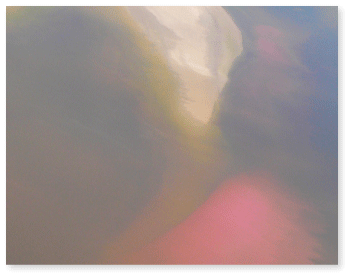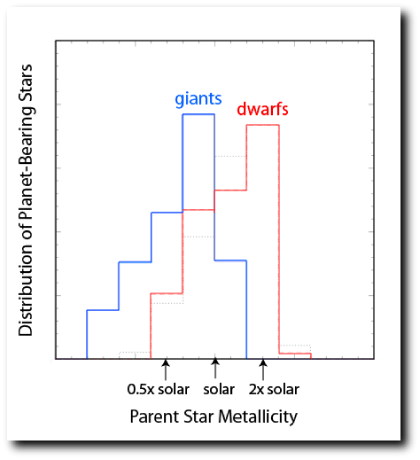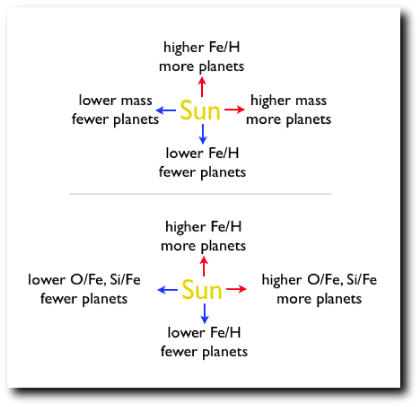
Image Source.
Mike Valdez pointed me to an interesting paper by Pasquini et al. that was posted to astro-ph today. The authors examined the frequency with which Jovian-mass planets are detected around giant stars and dwarf (that is, ordinary main sequence) stars as a function of the metallicity of the host star. Their main result is summed up in this redrawn figure:

The red histogram shows the well-known result that detectable Jovian-mass planets are preferentially found around metal-rich stars. The blue histogram shows a result that seems surprising at first glance. It indicates that for giant stars, the metallicity effect essentially goes away. The distribution in the blue histogram is not much different from the overall distribution of stellar metallicities in our local galactic neighborhood.
Pasquini et al. give several possible explanations for their result. Their favored interpretation is that the planet-metallicity correlation is due not to high intrinsic metallicity, but rather to stellar pollution. The idea is that after a planet-bearing star forms, its thin convective envelope is enriched by the accretion of heavy elements. The planet-bearing stars that have metal-rich spectra are in actuality ordinary stars sheathed in enriched envelopes. As polluted stars evolve off the main sequence, their convective envelopes grow deeper, and the apparent metallicity enhancements largely disappear.
As an inveterate adherent of the core-accretion hypothesis for the bulk of giant planet formation, my knee-jerk reaction is to be unhappy with a pollution interpretation. Disks and (by extension) stars that are metal-rich are more capable of building planetary cores while there’s still gas remaining in the protoplanetary disk. The planet-metallicity connection is thus a natural consequence of the core accretion hypothesis.
Pasquini et al. point out that the giant stars in their sample are systematically more massive than the main-sequence stars for which the planet-metallicity connection has been established. This leads them to speculate:
Since the fraction of planet-hosting giants is basically independent of metallicity, it is feasible that intermediate mass stars favor a planet formation mechanism, such as gravitational instability, which is independent of metallicity. One could speculate that such a mechanism is more efficient in more massive stars, which (likely) have more massive disks.
I don’t completely agree with this interpretation either, but I do think that the correct explanation is tied into a systematic difference in stellar mass between the giant sample and the dwarf sample. While it’s somewhat difficult to get accurate masses for giants, its reasonable to assume that the average mass of the giants in the above histogram is ~2 solar masses. If we assume that protostellar disks scale in mass with the mass of the parent star, then the average disk around a 2 solar mass star had roughly twice the surface density of solids than the average disk around a solar mass star. This is equivalent to a 0.3 dex increase in metallicity in a disk around a solar mass star, neatly explaining the magnitude of the offset between the red and the blue histograms.
The paucity of planets around high-metallicity giants probably stems in part from small number statistics and from the fact that there are very few super-metal-rich giants in the survey. Note that the histograms plot the distributions in metallicity for planet-bearing stars, and not the fraction of planet-bearing stars in a complete sample as a function of metallicity Although a detailed Monte-Carlo experiment is definitely in order, I think that Pasquini et al.’s result will end up being fully in line with the expectations of the core-accretion theory.
This argument would have had a lot more weight if I’d done a detailed Monte-Carlo analysis in advance, rather than monday-morning-armchair-quarterbacking (that is, blogging) with a smug postdiction. I think, however, that the core-accretion theory indicates that these general trends will all continue to hold true:


Talking of all these correlations, it looks like there’s another M-dwarf with two jovian mass planets… Gliese 317
Hi Greg,
I read the paper in its entirety and even copied it to my hard drive so that I may review it again. Needless to say, the pollution scenario is both shocking and unsettling at the same time. But, I take comfort in you statement: “The paucity of planets around high-metallicity giants probably stems in part from small number statistics and from the fact that there are very few super-metal-rich giants in the survey.” I believe that you are right in saying that a detailed Monte-Carlo experiment will place the Pasquini et al.’s result in line with the expectations of the core-accretion theory.
I am a fervent adherent to the core-accretion hypothesis, and I’m not about to abandon my faith in it, despite these new results.
best,
Eric
Furthermore, not only is Gliese 317 an M-dwarf, it is also low-metallicity! Not the kind of place you’d expect jovians…
Hi andy
It is the kind of result that gravitational instability expects though – a few Jovians where we don’t expect them to be.
In the end planets can form via either mechanism, and our observational research will be figuring out the relative numbers.
Well, I’ve reread the Pasquini et al paper three more times. And, I can’t find any fault in their methodology nor in their results. But, even Pasquini states in the abstract of the paper: “ we cannot exclude other explanationsâ€.
I can accept that there may be a small handful of yellow and orange giants in which the formation of their main-sequence progenitors may not be well understood, and that there is room for further investigation. I can even accept that some might even conform to the gravitational instability mechanism where dependence on metallicity is very weak. But, I do not believe that this is true of the vast majority of stars of the spectral type G III and K III. On the contrary, every scholarly paper that I have read about the formation of the progenitors of yellow and orange giants leads me to believe unequivocally that the vast majority of them were formed in strict adherence to the core-accretion hypothesis, and that the stars are indeed overmetallic right down to their centers.
Best,
Eric
I just read this manuscript on astro-ph regarding the metallicity
trends in planet-hosting giant stars and I found several potential
problems and errors.
First, the Fischer & Valenti
analysis of the convective zones (CZ) of subgiants pretty much closed the book on the planet
pollution hypothesis (Section 4.1). However, the conclusion of Pasquini et al. seems to imply
that the Fischer & Valenti analysis of the effects of CZ depth was incomplete and awaiting the
results of the Johnson et al. subgiants survey. This is an odd thing to assume since the
Fischer & Valenti sample contained 86 subgiants, 9 of which had planets. Their analysis
found no metallicity gradient with CZ depth–as would be expected if just the outer layers
were polluted—and no difference between the metallicity of the
9 planet hosting (PH) subgiants and the main-sequence planet host stars. Pasquini et al.
state “A dedicated study should be devoted to this point.” I wonder why they
don’t think the the Fischer & Valenti analysis qualifies as such!
I also wonder why the 9 PH subgiants from Fischer & Valenti and
the 4 PH subgiants from the Johnson et al. sample weren’t included in their
analysis. The convective zones of subgiants are significantly
deeper than those of main sequence stars. Even if the CZs of subgiants
are shallower than those of giants, the dilution of a polluted stellar atmosphere
should nonetheless be significant as the star crosses the Hertzsprung Gap. I
wonder how the inclusion of these 13 PH subgiants in their sample would
affect their conclusions. After all, the 9 PH subgiants in Fischer & Valenti had a
median metallicitiy of +0.35!
One possible explanation for the lower than average metallicities
of giants is not discussed in this paper: What if the metallicities of K giants
are systematically in error? I was disappointed to find no mention of this
possibility by the authors, who should certainly know that this is a
potential problem. K giants have relatively low surface gravities and
temperatures, and both of these features are notorious for introducing
non-LTE systematics that could “confuse” LTE spectral synthesis codes.
If there are reasons why the abundance measurements K giants are just as
reliable as main-sequence stars, it was not mentioned by the authors of this
paper.
Of course, as Greg pointed out, the authors missed the most interesting
possibility: Perhaps these giants actually do have lower than average
metallcities (which is certainly possible), but it’s their larger average *mass*
that has resulted in an an abundance of planets despite the low metal content
of their disks!
Hi John,
Thanks for the detailed post, and for fleshing out your arguments in detail. I’m in complete agreement…
My sense is that your giant star sample has a metallicity distribution that is more-or-less in line with the solar neighborhood distribution, is that right?
And no more M-dwarf Jovian-mass planet discoveries, please ;)
best,
Greg
Hi John,
You did a wonderful job of presenting very cogent arguments. I admit that I did not think of the many excellent points that you made in your post. And, I thank you for making them. I would also like to thank you for the link to the Fischer & Valenti paper. I was not aware of the existence of that paper until now, and you can rest assured that I will read it with great care.
best,
Eric
Not being a scientist, just a layperson, I find the prospect of exoplanets misbehaving to be reminiscent of when 51 Pegasi turned up where (almost) no one expected a Jovian to be.
Scientific discovery would be anti-climactic if it always followed our theories.
Both my original sample of 150 subgiants and my new, expanded sample of 300 additional stars have metallicity distributions very similar to the F, G and K stars in the solar neighborhood. I took special care to avoid a metallicity selection bias in my sample in an attempt to separate the known effect of metal abundance on giant planet occurrence from the unknown effect of stellar mass. The preliminary results of my study have been submitted to ApJ. Stay tuned!
Eric: I’m glad I was able to bring Fischer & Valenti to your attention. It’s the most detailed and careful analysis of the planet-metallicity correlation to date. It’s certainly one of the instant classics in the field of exoplanet research!
And I have to agree with graal on the subject of misbehaving planets! That’s one of the advantages of being an observer, we just report what we do or don’t find. Even null results are sometimes publishable, so it’s often win-win for us. GL317 came out of nowhere. Sorry about that one, Greg.
However, if GL317 causes problems for your prediction about planets around M dwarfs, the results from the other end of the stellar mass spectrum should vindicate the prediction that planet occurrence scales with stellar mass. Planets are popping up around subgiants faster than we can publish them! And in case anyone missed it, check out the huge planet host stars discovered by Lovis & Mayor. Christophe Lovis is targeting K giants in open clusters where he can control for metallicity and get very accurate stellar masses. Cool stuff.
Hi John,
Thanks for the link to the Lovis & Mayor paper. I saved the PDF file to my hard drive and will read it as soon as I’m finished with the Fischer & Valenti paper.
best,
Eric
Hi,
a little bit off topic.
Another massive planet around a metal poor solar mass star — HD 171028 (see exoplanet.eu). This adds to HD155358 just 6 weeks ago.
I was hoping for some planets around 61 Cyg ;)
Cheers, Luis
I like the simple explanation regarding disk mass too. Here’s my 5 cents…
So. If disk masses increase for higher mass stars (i.e. the disk mass relative to the star is constant), then a doubling of stellar mass allows a disk with roughly half the relative disk mass to form similar planets. This halving accounts for the metallicity shift of -0.3 dex. Nice.
However, if this were the case then only the low metallicity end of the distribution would move, but not the high end (i.e. the red histogram would widen to the left), since the higher metallicity disks can still presumably form planets.
The histogram makes it look like the whole distribution shifts, but perhaps the inclusion of the higher metallicity PH giants Johnjohn mentions changes the histogram such that this is the case…
And yeah, John please keep the (gas giant) PH M dwarfs to ~1%.
Hey Grant. Great point about the expansion of the distribution vs. translation. I bet if Pasquini et al. had included the subgiants from Fischer & Valenti that the distribution would indeed stretch. I’ve heard rumors that there’s another paper coming out soon dealing with this issue in further detail. Nothing like a good controversy to inspire people to get to the bottom of an issue!
We measure an occurrence rate of 1.8% for gas giants around M dwarfs. But that’s only for our sample of ~150 stars. There are another 100 to 150 M dwarfs on other surveys such as Endl et al. and Bonfils et al., and they haven’t found any giant planets in their samples. So unless those other teams are sitting on a couple Jupiters (highly unlikely), the 1.8% rate represents a pretty firm upper limit.